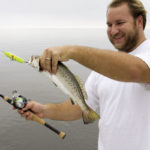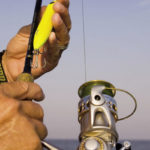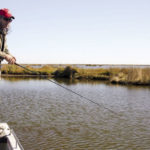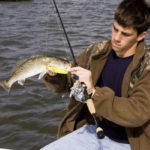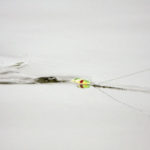
These two guides from very different areas agree that this is a great time to fish topwater baits for really big trout.
Who in their right mind would pick up a topwater rod during the middle of winter? It doesn’t seem like a very smart thing to do, but there is a contingent of speckled trout anglers who do just that when most everybody else is mining the bottom.
I first witnessed this phenomenon while fishing out of Hopedale with Capt. Charlie Thomason around Lake Robin. Not too long after that, Capt. T-Man Cheramie picked up a topwater rod while we were fishing the Sulfur Mine just to the east of Galliano.
Although I don’t recall either angler just whacking the speckled trout with their topwaters, I do remember both of them telling me two days into a warming trend that it was one day too early for the topwater bite to be on.
“I like to throw topwaters during winter because you can catch the big boys,” Cheramie asserted, “but it’s got to warm up at least three days in a row before the trout get on them. The best time to throw topwaters during the winter is on the third day with 70-degree temperatures.”
During cold weather, trout bunch up in the deepest holes they can find in an area. Around the Sulfur Mine, that means Bayou Blue or the middle of the Sulfur Mine itself. Out of Hopedale, the deep water can be found in places like the Twin Pipeline and Oak River.
Imagine, if you will, a bunch of New Yorkers jammed into a subway car. That’s about what it would look like if you could see the trout packed thickly at the bottom of these holes.
However, extend your imagination to when the passengers exit the underground train. They each go their separate ways and spread throughout the city. Trout kind of do the same thing on that third day of warm weather.
“Fish don’t like being bunched up on top of each other,” Cheramie surmised. “As soon as that water warms up a little bit, they start spreading out into the nearby ponds in about 3 feet of water. At least the big boys do.”
Thomason explained that the same scenario plays out around Hopedale where trout that have transitioned into the interior marsh spend the cold days and nights mainly on the bottom of the deeper holes. And unlike Cheramie, Thomason doesn’t give them three days to turn on.
“You can actually fish the flats surrounding the deep holes later in the day after the sun warms the shallows,” Thomason said. “I kind of ease up there throwing suspending baits, but topwaters are great to throw during the warmest part of the day. No doubt I catch bigger trout on the hard baits.”
Both saltwater guides believe that long stretches of deep water like Bayou Blue around the Sulfur Mine and the Twin Pipelines out of Hopedale provide anglers with ample opportunities to locate the perfect combination of deep and shallow water.
“The Sulfur Mine is about the only place I really fish topwaters this time of year,” Cheramie admitted, “but you can do it down toward Catfish Lake and some — but not too much — around Gray Duck Lake. A lot of trout stack up in Bayou Blue during the cold weather, and Bayou Blue connects several of these lakes with shallow flats.”
Since the topwater bite really doesn’t turn on until the water has a chance to warm up whether it’s daily or after a three-day stretch, Cheramie says the late afternoon until dark is the best time to throw surface baits.
“Me, I won’t even start throwing it until around 3:00 on a good warm day,” Cheramie said. “That gives those big boys a good chance to move up there in that shallow water where they can soak up the warmth. And when they’re up there, they’re definitely looking for something to eat.”
Even though the fish are actively looking to feed, Cheramie says trout don’t attack the topwaters during the winter like they do during the summer. Rather than explode on them, they simply rise up under a topwater and slurp it down.
In fact, Cheramie has found that more often than not, trout hit his Top Dog Jr. when he’s letting it sit there after walking it a few times.
“It’s almost like they eat it when you kind of forget about it sitting there,” Cheramie said. “Sometimes you have trouble hooking them because they don’t smash it like they do later in the year. That’s why I like sharp hooks. I used to change all my topwater hooks to those Excalibur hooks because the trout couldn’t throw them. Those things were so sharp that I would hook myself 10 times while trying to change them out.”
However, Cheramie found that these freshwater hooks, as sharp as they were, just didn’t stand up to the saltwater environment like he needed them to. They frequently rusted to the point of being worthless. Now, Cheramie just sharpens what comes on his topwaters.
“I like the smaller hooks, too,” Cheramie added. “No big ones. I can get the smaller ones sharper, and they hook a big trout better than big hooks. With sharp hooks, I’d say you get maybe a 75-percent better hookset. But you know how it is with topwaters; you’re still going to lose a bunch of fish.”
Another way that Cheramie tries to improve his chances of landing a really big trout is by using a flimsy 7- or 7 1/2-foot rod. He simply reasoned that “you don’t pull the frickin’ bait out of his mouth.”
“A lot of times, people snatch the rod as soon as they see a bite because they get so excited,” Cheramie said. “You got to be patient when they bite, and that’s where a good long, flimsy rod will help out. It gives with the fish and acts like a shock absorber. A flimsy rod will also help you any time you’re fishing topwaters.”
Actually, Cheramie doesn’t even set the hook at all when fishing topwaters during the winter. Rather, he makes sure his topwater has disappeared from the surface, and then he just starts reeling.
Reeling puts enough pressure on the hooks to stick them in, which they will if they are sharp enough. Then Cheramie allows the rod to catch the fish.
Over on the east side of the Mississippi River, Thomason practices many of the same topwater techniques as Cheramie, but he says his topwater success comes from constantly staying on the lookout for big schools of mullet on the flats in 1 to 3 fee2t of water.
“I definitely look for the mullet,” Thomason said. “They are more of a key for me than just about anything else — current, tide, whatever. If the mullet are there, the big trout are there. If I pull in to a couple small ponds and drift through without seeing any mullet, I would have to say I wouldn’t have very many fish in the box.”
Like Cheramie, Thomason believes one key to catching topwater trout during the winter is to fish them just as slowly as you can possibly stand it. Another key is to make as long a cast as you can.
“I like to work my topwaters with a constant retrieve but as slow as I can,” Thomason said. “I tell my customers to try to fish them as slow as they can while still keeping the bait moving forward. As long as you feel resistance on the pole, then you know you’re working it right. If you’re reeling and you can’t feel any resistance, then you know you’re working to slow.”
Fishing topwaters during the winter isn’t for those anglers who just want to go out and fill their boxes quickly enough that they can be back home in time for lunch. Rather, this kind of fishing is for those who don’t mind coming back to the ramp with 10 big trout rather than 25 small ones.
For Cheramie, big means 4- and 5-pound trout around the Sulfur Mine. He’s caught them bigger, and he knows of one over 10 pounds that was caught on a topwater a couple years ago, but the really big boys are fewer and farther between in his neck of the woods.
On the other hand, Thomason says topwaters south of Hopedale are for those anglers who are getting tired of popping a cork to catch small trout. He says the topwaters in his neck of the woods catch trout up to 7 and 8 pounds during the winter.
“Topwaters are definitely more about quality than they are quantity this time of year,” Thomason added. “If you’re happy with school trout, get in deep water and fish the bottom or stick with the cork. But if you want a really big trout, tie on a topwater and get on the shallow flats.”
It may not seem like a very smart decision to tie on a topwater during a season when you can hardly feel your fingers. But if you follow these two anglers’ advice, you’ll be picking up your topwater rod more and more during the winter months.
They’re not as out of their minds as you might think.
Contact Capt. T-Man Cheramie at 985-693-6828 and Capt. Charlie Thomason at 504-278-FISH.
